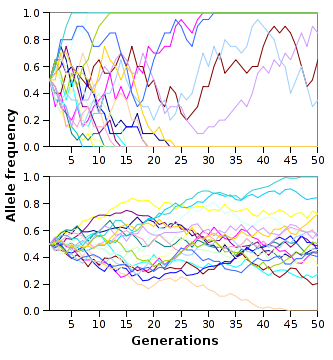Evolution

|
This article provides an overview of the Evolution of populations and the mechanisms that derive it.
Contents
What is Evolution?
The theory of evolution explains how populations of organisms have changed over time. Evolution does not refer to changes that occur in an individual within its lifetime but it refers to changes in the characteristics of populations over the generations. These changes, which include modifications in structure, physiology, ecology and behaviour, may be so small that it is difficult to detect them or such great that the population differs from its ancestral population noticeably. Eventually, two populations may diverge to such a degree that we refer to them as different species.
Evolution has two main perspectives: microevolution and macroevolution. The evolution of populations is best understood in terms of phenotype, genotype and allele frequencies.
Understanding The Evolution
The understanding of evolutionary biology began with the 1859 publication of Charles Darwin's On the Origin of Species. In addition, Gregor Mendel's work with plants helped to explain the hereditary patterns of genetics.
Although Charles Darwin is universally associated with evolution, ideas of evolution predate Darwin by centuries. Aristotle (384-322 B.C.) saw much evidence of natural affinities among organisms. This led him to arrange all of the organisms he knew in a “Scale of Nature” that extended from the exceedingly simple to the most complex. His was vague to the nature of this “movement toward perfection” and certainly did not propose that the process of evolution was driven by natural processes.
Evolution - Deriving Mechanisms
Two major mechanisms drive evolution; the first is natural selection and the second is genetic drift. Other mechanisms evolving in the evolutionary process are:
Each population possesses a gene pool including all the alleles for all the genes present in it. Allele and/or genotype frequencies may be changed by the evolution deriving mechanisms.
Natural Selection
Charles Darwin, in his 1859 seminal book, “On the Origin of Species”, named the differential survival and reproductive success of individuals as natural selection. By natural selection, individuals of a population that enjoy more successful adaptations to the environment have more chances to survive and reproduce. Natural selection fights back seriously abnormal phenotypes as well as eliminates harmful mutations or reduces them. Over successive generations, the proportion of favourable alleles cause the population to increase. In contrast with other microevolutionary processes, natural selection leads adaptive evolutionary change.
Natural selection results in the preservation of individuals with favourable phenotypes and elimination of those with unfavourable phenotypes. Individuals that are able to survive and produce fertile offspring have a selective advantage.
Natural selection explains why organisms are well adapted to the environments in which they live but also helps to account for the diversity of life. Natural selection enables populations to change, thereby adapting to different environments and different ways of life.
The mechanism of natural selection does not cause the development of “perfect” organisms; it wipes out those individuals whose phenotypes are not as well adapted to the environment as other, while allow better adapted individuals to survive and reproduce.
Genetic Drift
The production of random evolutionary changes in small breeding populations is known as Genetic drift. It results in changes in allele frequencies in a population from one generation to another. One allele may be eliminated from the population purely by chance, regardless of whether that allele is beneficial, harmful or of no particular advantage or disadvantage. Genetic drift, although it tends to increase the genetic differences among different populations, it can also decrease genetic variation within a population.
In case of a population getting through a bottleneck, genetic drift can become a major evolutionary force. After the bottleneck, as the population increases again in size, many allele frequencies may be quite different from those in the population preceding the decline.
Please note that others may also have edited the contents of this article.
|

